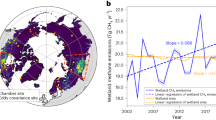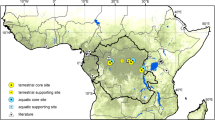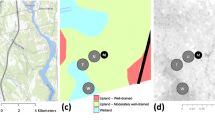Abstract
Wetlands are the largest global source of atmospheric methane (CH4)1, a potent greenhouse gas. However, methane emission inventories from the Amazon floodplain2,3, the largest natural geographic source of CH4 in the tropics, consistently underestimate the atmospheric burden of CH4 determined via remote sensing and inversion modelling4,5, pointing to a major gap in our understanding of the contribution of these ecosystems to CH4 emissions. Here we report CH4 fluxes from the stems of 2,357 individual Amazonian floodplain trees from 13 locations across the central Amazon basin. We find that escape of soil gas through wetland trees is the dominant source of regional CH4 emissions. Methane fluxes from Amazon tree stems were up to 200 times larger than emissions reported for temperate wet forests6 and tropical peat swamp forests7, representing the largest non-ebullitive wetland fluxes observed. Emissions from trees had an average stable carbon isotope value (δ13C) of −66.2 ± 6.4 per mil, consistent with a soil biogenic origin. We estimate that floodplain trees emit 15.1 ± 1.8 to 21.2 ± 2.5 teragrams of CH4 a year, in addition to the 20.5 ± 5.3 teragrams a year emitted regionally from other sources. Furthermore, we provide a ‘top-down’ regional estimate of CH4 emissions of 42.7 ± 5.6 teragrams of CH4 a year for the Amazon basin, based on regular vertical lower-troposphere CH4 profiles covering the period 2010–2013. We find close agreement between our ‘top-down’ and combined ‘bottom-up’ estimates, indicating that large CH4 emissions from trees adapted to permanent or seasonal inundation can account for the emission source that is required to close the Amazon CH4 budget. Our findings demonstrate the importance of tree stem surfaces in mediating approximately half of all wetland CH4 emissions in the Amazon floodplain, a region that represents up to one-third of the global wetland CH4 source when trees are combined with other emission sources.
This is a preview of subscription content, access via your institution
Access options
Access Nature and 54 other Nature Portfolio journals
Get Nature+, our best-value online-access subscription
$29.99 / 30 days
cancel any time
Subscribe to this journal
Receive 51 print issues and online access
$199.00 per year
only $3.90 per issue
Buy this article
- Purchase on Springer Link
- Instant access to full article PDF
Prices may be subject to local taxes which are calculated during checkout

Similar content being viewed by others
Change history
13 December 2017
Please see accompanying Erratum (http://doi.org/10.1038/nature25191). In this Letter, author ‘Humberto Ribeiro’ has been corrected to ‘Humberto Marotta’, and the Acknowledgements and Author Contributions have been corrected accordingly.
References
Kirschke, S. et al. Three decades of global methane sources and sinks. Nat. Geosci. 6, 813–823 (2013)
Bloom, A. A., Palmer, P. I., Fraser, A. & Reay, D. S. Seasonal variability of tropical wetland CH4 emissions: the role of the methanogen-available carbon pool. Biogeosciences 9, 2821–2830 (2012)
Melack, J. M. et al. Regionalization of methane emissions in the Amazon Basin with microwave remote sensing. Glob. Change Biol. 10, 530–544 (2004)
Bergamaschi, P. et al. Inverse modeling of global and regional CH4 emissions using SCIAMACHY satellite retrievals. J. Geophys. Res. D 114, (2009)
Frankenberg, C. et al. Pressure broadening in the 2 nu(3) band of methane and its implication on atmospheric retrievals. Atmos. Chem. Phys. 8, 5061–5075 (2008)
Pangala, S. R., Hornibrook, E. R. C., Gowing, D. J. & Gauci, V. The contribution of trees to ecosystem methane emissions in a temperate forested wetland. Glob. Change Biol. 21, 2642–2654 (2015)
Pangala, S. R., Moore, S., Hornibrook, E. R. C. & Gauci, V. Trees are major conduits for methane egress from tropical forested wetlands. New Phytol. 197, 524–531 (2013)
Devol, A. H., Richey, J. E., Forsberg, B. R. & Martinelli, L. A. Seasonal dynamics in methane emissions from the Amazon River floodplain to the troposphere. J. Geophys. Res. D 95, 16417–16426 (1990)
Bartlett, K. B. et al. Methane flux from the central Amazonian floodplain. J. Geophys. Res. D 93, 1571–1582 (1988)
Ringeval, B. et al. Methane emissions from floodplains in the Amazon Basin: Challenges in developing a process-based model for global applications. Biogeosciences 11, 1519–1558 (2014)
Webb, A. J. et al. CH4 concentrations over the Amazon from GOSAT consistent with in situ vertical profile data. J. Geophys. Res. D 121, 11006–11020 (2016)
Chou, W. W. et al. Net fluxes of CO2 in Amazonia derived from aircraft observations. J. Geophys. Res. D 107, (2002)
Frankenberg, C., Meirink, J. F., van Weele, M., Platt, U. & Wagner, T. Assessing methane emissions from global space-borne observations. Science 308, 1010–1014 (2005)
Bloom, A. A. et al. Global methane emission estimates from ultraviolet irradiation of terrestrial plant foliage. New Phytol. 187, 417–425 (2010)
Martinson, G. O. et al. Methane emissions from tank bromeliads in neotropical forests. Nat. Geosci. 3, 766–769 (2010)
Beck, V. et al. Methane airborne measurements and comparison to global models during BARCA. J. Geophys. Res. D 117, (2012)
Rusch, H. & Rennenberg, H. Black alder (Alnus glutinosa (L.) Gaertn.) trees mediate methane and nitrous oxide emission from the soil to the atmosphere. Plant Soil 201, 1–7 (1998)
Pangala, S. R., Gowing, D. J., Hornibrook, E. R. C. & Gauci, V. Controls on methane emissions from Alnus glutinosa saplings. New Phytol. 201, 887–896 (2014)
Sawakuchi, H. O. et al. Methane emissions from Amazonian Rivers and their contribution to the global methane budget. Glob. Change Biol. 20, 2829–2840 (2014)
Belger, L., Forsberg, B. R. & Melack, J. M. Carbon dioxide and methane emissions from interfluvial wetlands in the upper Negro River basin, Brazil. Biogeochemistry 105, 171–183 (2011)
Schaefer, H. et al. A 21st-century shift from fossil-fuel to biogenic methane emissions indicated by 13CH4 . Science 352, 80–84 (2016)
Hess, L. L. et al. Wetlands of the lowland Amazon basin: extent, vegetative cover, and dual-season inundated area as mapped with JERS-1 Synthetic Aperture Radar. Wetlands 35, 745–756 (2015)
Covey, K. R., Wood, S. A., Warren, R. J., Lee, X. & Bradford, M. A. Elevated methane concentrations in trees of an upland forest. Geophys. Res. Lett. 39, (2012)
Pitz, S. & Megonigal, J. P. Temperate forest methane sink diminished by tree emissions. New Phytol. 214, 1432–1439 (2017)
Wang, Z. P. et al. Methane emissions from the trunks of living trees on upland soils. New Phytol. 211, 429–439 (2016)
Wilson, C. et al. Contribution of regional sources to atmospheric methane over the Amazon Basin in 2010 and 2011. Glob. Biogeochem. Cycles 30, 400–420 (2016)
Latrubesse, E. M. et al. Damming the rivers of the Amazon basin. Nature 546, 363–369 (2017)
Hess, L. L., Melack, J. M., Novo, E., Barbosa, C. C. F. & Gastil, M. Dual-season mapping of wetland inundation and vegetation for the central Amazon basin. Remote Sens. Environ. 87, 404–428 (2003)
Siegenthaler, A., Welch, B., Pangala, S. R., Peacock, M. & Gauci, V. Semi-rigid chambers for methane gas flux measurements on tree stems. Biogeosciences 13, 1197–1207 (2016)
Bastviken, D., Cole, J. J., Pace, M. L. & de Bogert, M. C. Fates of methane from different lake habitats: connecting whole-lake budgets and CH4 emissions. J. Geophys. Res. Biogeosci. 113, G02024 (2008)
Fisher, R., Lowry, D., Wilkin, O., Sriskantharajah, S. & Nisbet, E. G. High-precision, automated stable isotope analysis of atmospheric methane and carbon dioxide using continuous-flow isotope-ratio mass spectrometry. Rapid Commun. Mass Spectrom. 20, 200–208 (2006)
Keppler, F. et al. Measurements of 13C/12C methane from anaerobic digesters: comparison of optical spectroscopy with continuous-flow isotope ratio mass spectrometry. Environ. Sci. Technol. 44, 5067–5073 (2010)
Santiago, L. S., Goldstein, G., Meinzer, F. C., Fownes, J. H. & Mueller-Dombois, D. Transpiration and forest structure in relation to soil waterlogging in a Hawaiian montane cloud forest. Tree Physiol. 20, 673–681 (2000)
Melack, J. M . et al. Monthly mean flooded wetlands habitat, Central Amazon Basin : 1979–1996. LBA-ECO LC-07(Oak Ridge National Laboratory Distributed Active Archive Center, 2011); https://doi.org/10.3334/ORNLDAAC/1049.
Miller, J. B. et al. Airborne measurements indicate large methane emissions from the eastern Amazon basin. Geophys. Res. Lett. 34, L10809 (2007)
Draxler, R. R. & Hess, G. D. An overview of the HYSPLIT_4 modelling system for trajectories, dispersion, and deposition. Aust. Meteorol. Mag. 47, 295–308 (1998)
Acknowledgements
The bottom-up measurement study was funded by grants from the following bodies: UK Natural Environment Research Council to V.G. (Principal Investigator, grant NE/J010928/1) and E.R.C.H. (co-investigator, NE/J009032/1); several CNPq (Brazil National Council of Research and Development) and FAPERJ (Science Foundation from the State of Rio de Janeiro) grants to A.E.-P.; Swedish Research Council, VR (grant 2012-00048) to D.B.; and the Swedish-Brazilian collaboration STINT/CAPES to D.B. and A.E.-P. (grant 2012-2085). Atmospheric CH4 vertical profile measurements were funded by the following agencies: NERC consortium AMAZONICA, which is led by E.G. (grant NE/F005806/1) and includes L.V.G. and J.B.M.; FAPESP (State of Sao Paulo Science Foundation) via the Carbon Tracker project and FAPESP-NERC via the ACO project (grants 08/58120-3, 11/51841-0); the EU via the 7th-Framework Programme project GEOCARBON (grant 283080); and CNPq (grant 403241/2012-3, awarded to L.V.G.). NASA, NOAA, IPEN and INPE contributed to the construction and maintenance of the GHG laboratory in Brazil. We also acknowledge support from the FAPESP-NERC ACO project for a workshop that brought bottom-up and top-down data together. V.G. and E.G. thank the NERC consortium MOYA (grant NE/N015606/1) and D.B. thanks the Swedish Research Council (VR) for salary contributions. V.G. and S.R.P. acknowledge support from the AXA Research Fund. We thank T. Silva for assistance with tree species identification and A. Breves, E. Cristina, F. M. Silva, J. Valle, J. P. Felizardo, L. Rodrigues, L. Valladares, P. Souto, R. Pollery and V. Figueiredo for field work assistance. We thank A. Dwarakanath for data analysis and P. Monaghan and A. McAleer for performing δ13C-CH4 analyses.
Author information
Authors and Affiliations
Contributions
S.R.P., V.G., A.E.-P. and D.B. conceived and designed the bottom-up measurement study. The Brazil expeditions (bottom-up measurements) in 2013 and 2014 were planned and organised by A.E.-P., O.M., W.R.B., R.B.P. and S.R.P. and carried out by S.R.P., R.B.P., H.M., L.S.B.C. and W.R.B. The δ13C-CH4 analysis was performed by E.R.C.H., who also interpreted those data. L.S.B.C. and C.M.S. identified the tree species in the 2014 Brazil expedition. The top-down measurement study was designed and carried out by L.S.B., L.V.G., J.B.M. and E.G. V.G. coordinated the integration of the various elements of the study. S.R.P., V.G., L.S.B., E.G., D.B., E.R.C.H. and A.E.-P. contributed to the writing of the manuscript.
Corresponding authors
Ethics declarations
Competing interests
The authors declare no competing financial interests.
Additional information
Reviewer Information Nature thanks C. Frankenberg, F. Keppler, P. Megonigal and the other anonymous reviewer(s) for their contribution to the peer review of this work.
Publisher's note: Springer Nature remains neutral with regard to jurisdictional claims in published maps and institutional affiliations.
Supplementary information
Supplementary Information
This file contains Supplementary Figures 1-2 and Supplementary Tables 1-5. (PDF 1382 kb)
PowerPoint slides
Rights and permissions
About this article
Cite this article
Pangala, S., Enrich-Prast, A., Basso, L. et al. Large emissions from floodplain trees close the Amazon methane budget. Nature 552, 230–234 (2017). https://doi.org/10.1038/nature24639
Received:
Accepted:
Published:
Issue Date:
DOI: https://doi.org/10.1038/nature24639
This article is cited by
-
Revealing the hidden carbon in forested wetland soils
Nature Communications (2024)
-
Dissolved greenhouse gas (CO2, CH4, and N2O) emissions from highland lakes of the Andes cordillera in Northern Ecuador
Aquatic Sciences (2024)
-
Drivers of intra-individual spatial variability in methane emissions from tree trunks in upland forest
Trees (2024)
-
Andean headwater and piedmont streams are hot spots of carbon dioxide and methane emissions in the Amazon basin
Communications Earth & Environment (2023)
-
Tree Foliage is a Methane Sink in Upland Temperate Forests
Ecosystems (2023)
Comments
By submitting a comment you agree to abide by our Terms and Community Guidelines. If you find something abusive or that does not comply with our terms or guidelines please flag it as inappropriate.



